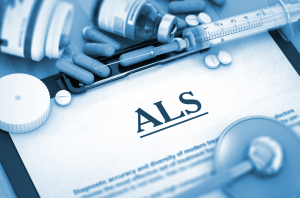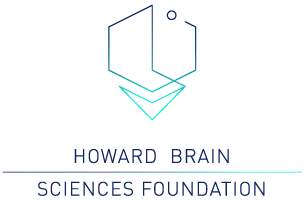This week and next week on the Brain Blog we will be presenting an overview of ALS followed by a review of cutting edge treatments and research on ALS. After exploring ALS, the remainder of May we will be discussing mental health in honor of Mental Health Awareness month.
Amyotrophic lateral sclerosis (ALS) “is a neurodegenerative disease characterized by progressive muscular paralysis reflecting degeneration of motor neurons in the primary motor cortex, corticospinal tracts, brainstem, and spinal cord” (Wijesekera & Leigh, 2009). This most notably manifests in muscle stiffening, muscle twitching, and gradual atrophy, though it may also include “hyporeflexia, muscle cramps, and fasciculations” (Siddique & Siddique, 1993). It has been reported that upwards of “45% of individuals with ALS have some degree of cognitive impairment at some time during their illness” due to frontotemporal degeneration (Siddique & Siddique, 1993). Most ALS patients eventually lose the ability to breathe, walk, swallow, speak, or use their hands (Hobson & McDermott, 2016).
ALS is both a blanket term “used to cover the spectrum of neurodegenerative syndromes characterized by progressive degeneration of motor neurons” and a specific term “used in modern clinical practice to indicate the commonest form of the disease, Classical (Charcot’s) ALS” (Wijesekera & Leigh, 2009). Other related syndromes include “Progressive bulbar palsy (PBP), Progressive muscular atrophy (PMA), Primary lateral sclerosis (PLS), Flail arm syndrome (Vulpian-Bernhardt syndrome), Flail leg syndrome (Pseudopolyneuritic form) and ALS with multi-system involvement (e.g., ALS-Dementia)” (Wijesekera & Leigh, 2009).
ALS patients often self-report symptoms, then undergo further testing with a neurologist or physician (National Institute of Neurological Disorders and Stroke, 2020). ALS testing then requires a full physical examination and several tests to rule out other possibilities (National Institute of Neurological Disorders and Stroke, 2020). The Escorial criteria (revised) and Awaji criteria are both used to diagnose ALS (Brooks, Miller, Swash, Munsat & World Federation of Neurology Research Group on Motor Neuron Diseases, 2000; Siddique & Siddique, 1993). The Awaji diagnostic criteria require evidence of lower motor neuron (LMN) degeneration by clinical, electrophysiologic, or neuropathologic examination, evidence of upper motor neuron (UMN) degeneration by clinical examination, and progressive spread of symptoms or signs within a region or to other regions, as determined by history or examination (Brooks et al., 2000). However, the following features must also be absent: electrophysiologic or pathologic evidence of other disease processes that could explain the signs of LMN and/or UMN degeneration, and neuroimaging evidence of other disease processes that could explain the observed clinical and electrophysiologic signs (Brooks et al., 2000). The Escorial criteria are then used to determine one of the following diagnoses: clinically definite ALS, clinically definite familial ALS, laboratory-supported ALS, clinically probable ALS, clinically probable, laboratory-supported ALS, clinically possible ALS, and clinically suspected ALS (Brooks et al., Siddique & Siddique, 1993). Patients may be additionally tested for frontotemporal spectrum involvement and neuropsychological complications (Siddique & Siddique, 1993).
Around 5,000 people are diagnosed with ALS per year, the diagnosis is more common in men (The ALS Association, 2020; Wijesekera & Leigh, 2009). Most cases have their onset between the ages of 40 and 70, the average age of diagnosis being 55 (The ALS Association, 2020; Wijesekera & Leigh, 2009). Treatment is palliative as there is no cure for ALS (Siddque & Siddque, 1993). Two common drugs for treating ALS are Riluzole and Edaravone (Siddque & Siddque, 1993). Riluzole has “demonstrated marginal slowing of disease progression in some but not all patients demonstrated marginal slowing of disease progression in some but not all patients” and in its Rilutek form “is thought to act by inhibiting the production of glutamate” (Siddique & Siddique, 1993). Edaravone is a free radical scavenger and “is given by slow intravenous infusion on the first 10-14 days of a 28-day cycle” (Siddique & Siddique, 1993). Other drug treatments are also used for symptom management in conjunction with assistance devices for tasks such as movement, communication, and breathing.
Ventilatory and nutrition management are also commonly needed due to difficulty breathing and eating (Wijesekera & Leigh, 2009). Ventilatory assistance “has played an increasing role in preserving and prolonging quality of life in persons with ALS” (Siddique & Siddique, 1993). Symptoms determinable by examination “include tachypnoea, use of accessory breathing muscles, paradoxical movement of the abdomen, weak cough and rarely papilloedema,” while symptoms that can often be determined without examination “include dyspnoea on exertion or talking, orthopnea, disturbed sleep, excessive daytime somnolence, morning headaches, fatigue, anorexia, depression, poor concentration, vivid nightmares and nocturia”(Wijesekera & Leigh, 2009). Treatment for dysphagia may consist of “percutaneous endoscopic gastrostomy (PEG), percutaneous radiologic gastrostomy (PRG) or radiologically inserted gastrostomy (RIG), and nasogastric tube (NGT) feeding” (Wijesekera & Leigh, 2009).
For more information about ALS, you can read our upcoming post on the Brain Blog next week or reach out to organizations such as the ALS Therapy Development Institute, and the ALS Association.
Written by Senia Hardwick
References
Brooks, B. R., Miller, R. G., Swash, M., Munsat, T. L., & World Federation of Neurology Research Group on Motor Neuron Diseases. (2000). El Escorial revisited: Revised criteria for the diagnosis of amyotrophic lateral sclerosis. Amyotrophic Lateral Sclerosis and Other Motor Neuron Disorders: Official Publication of the World Federation of Neurology, Research Group on Motor Neuron Diseases, 1(5), 293–299. https://doi.org/10.1080/146608200300079536
Hobson, E. V., & McDermott, C. J. (2016). Supportive and symptomatic management of amyotrophic lateral sclerosis. Nature Reviews Neurology, 12(9), 526–538. https://doi.org/10.1038/nrneurol.2016.111
National Institute of Neurological disorders and Stroke. (2020). Amyotrophic lateral sclerosis (Als) fact sheet . https://www.ninds.nih.gov/Disorders/Patient-Caregiver-Education/Fact-Sheets/Amyotrophic-lateral-Sclerosis-ALS-Fact-Sheet
Siddique, N., & Siddique, T. (1993). Amyotrophic lateral sclerosis overview. In M. P. Adam, H. H. Ardinger, R. A. Pagon, S. E. Wallace, L. J. Bean, K. Stephens, & A. Amemiya (Eds.), GeneReviews®. University of Washington, Seattle. http://www.ncbi.nlm.nih.gov/books/NBK1450/
The ALS Association. (2020). Facts You Should Know. http://www.alsa.org/about-als/facts-you-should-know.html
Wijesekera, L. C., & Leigh, P. N. (2009). Amyotrophic lateral sclerosis. Orphanet Journal of Rare Diseases, 4, 3. https://doi.org/10.1186/1750-1172-4-3
